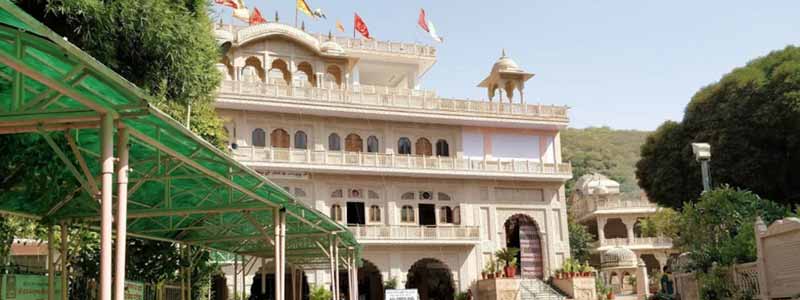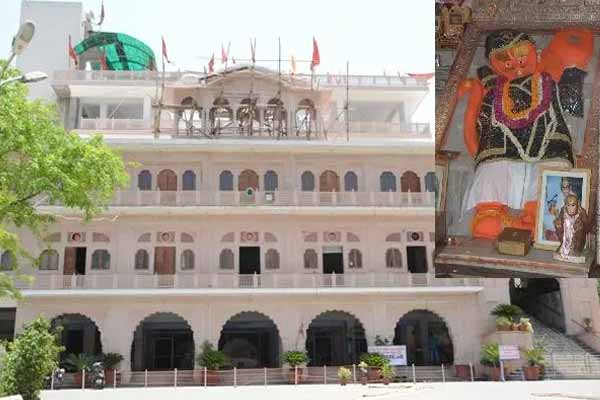Khole Ke Hanuman Ji Temple Jaipur is dedicated to the Hindu God Hanumanji. The temple is stationed at the Delhi- Jaipur bypass and is situated at the hilltop giving the visitors a panoramic and wide-angle view of the hills that surrounds the mandir.
Besides the mandir, there is an altar that can hold up to 500 people at a time. The Khole Ke Hanuman ji temple was built by Pandit Radhe Lal Choubey in 1960 and it is believed that once, RadheLal Ji was chilling while he spots a Hanumaanji carving out of the rock.
He envisioned it to be as a sign from God to build a Mandir and so he did. According to the legends, it is believed that the area was known as Narwar Das Ke Khol which is the place where Baba Nirmal Das spent the rest of his life dedicated to lord Hanumaanji centuries ago.
The temple is spread about 100 square feet area in the Laxman Dungri Hills. With the flow in time, the temple complex expanded and new constructions were built in and around the pilgrim Religious Places in Rajasthan.
Though there are several Jaipur tourist places to visit without any doubt this is one of them. Hence this amazing place should add into JAIPUR TOUR PACKAGES. So we will say if there is a plan to visit in Jaipur, this place should not miss anyway.

History and Legend behind Khole Ke Hanuman Temple
The temple situated on a hill top and surrounded by hills on three sides, was commissioned by Pandit Radhe Lal Choubey, a resident of Jamwa Ramgarh, after he chanced upon a rock with carving of Lord Hanuman. Taking it as a cue, he decided to build a temple at the site in 1961.
Pandit Choubey had already started offering his prayers long before the temple was established. It is believed that Baba Nirmal Das used to worship Lord Hanuman at the same site a few centuries ago and this site was earlier called Narwar Dar Ki Khol. Pandit Radhe Lal Choubey also played an instrumental role in coming up with the Narwar Ashram Seva Samiti, a community that dedicatedly worked towards the temple building.
At the time when the temple was built, it occupied only 100 square feet of area at the site of Laxman Doongari hill. As time passed and the temple gained popularity, the temple complex was expanded and today, it is spread across several acres of land (around 300 times compared to the initial area) with a grand structure for the temple.
The name of the temple, ‘Khole Ke Hanuman’ was termed after the word ‘Khola’, which means valley in local language.
Architecture of Khole Ke Hanuman Temple
The Khole Ke Hanuman Ji Temple is built in a typical mix of Rajput and Mughal styles of architecture. It majorly appears like a replica of any Rajput palace, made out of Dholpur sandstone and marble, with domes and walkways lined with carved columns. The abundance of latticed windows and chhatris does add to the elegance of the temple structure.
The central location of the temple complex is dedicated to the sanctum sanctorum, where the original idol of the presiding deity is placed. It is a tiny room inside a huge building, and the idol of the deity is installed on a single piece of marble stone.
Apart from the main deity, the temple complex also houses small temples dedicated to Goddess Durga, Lord Ram, Lord Ganesha and Lord Shiva. The Shiva temple also has replicas of the 12 jyotirlingas.
The temple complex has lush gardens, guest houses, kitchens and dining areas for visitors. The dining areas are so huge that they can serve up to 5000 people at a time. The lawns outside the temple are beautifully manicured with seating areas and chhatris. There is a marble chhatri dedicated to Pandit Radhe Lal Choubey, the founder of the temple.
How To Reach Khole Ke Hanuman Ji Temple
Khole Ke Hanuman Ji Temple is located amidst the Lakshman Dungri Hills close to the Delhi Bypass road, about 13 kilometres to the north-east if Jaipur city centre. It is easily accessible by the roadways within the city and people can choose one of the three routes that lead to the temple.
The first route goes via Shanti Path – NH 248, the second goes via Tonk Road – NH 248 and the third goes through NH 248 – Galta Road. Rental cabs are best for tourists as they can cover several attractions in a day. Otherwise, an auto-rickshaw, a tuk-tuk or a local bus ride can be a good option to commute shorter distances in the city.
